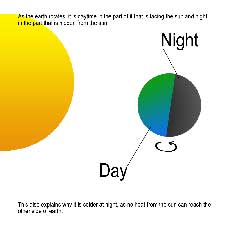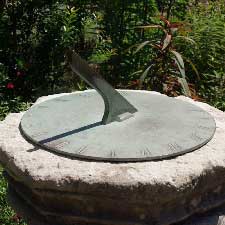Night and Day
Why do we have night and day?
We are able to separate between night and day because during the day we have sunlight and during the night there is no sunlight. The reason for this is that the Earth is constantly turning on its axis which is an imaginary line that passes between the North and South Poles. Light from the Sun will only shine on the half of the Earth that is facing the Sun. On the other half of the Earth there will be darkness because no sunlight can reach the other side.
It takes the Earth 24 hours to complete a full spin on its axis and that is why a day lasts for 24 hours. Similarly, if only one half of the Earth sees the Sun at a time, that is why daylight is 12 hours and a night-time is 12 hours.
Why does the Sun seem to move across the sky?
It is not the Sun that is moving across the sky, it only looks like the Sun is moving because the Earth is spinning on its axis. It looks like the Sun is moving across the sky from east to west but it is in fact the Earth spinning on its axis from west to east.
This is why the Sun rises in the east and sets in the west. When it is night-time and we can no longer see the Sun the same effect happens with stars – it looks like the stars are moving from east to west in the sky, but this is just the Earth spinning on its axis.
What causes a sunrise and sunset?
A sunrise and sunset is caused when the Earth in your particular location has beginning to face the Sun (sunrise) or starting to face away from the Su (sunset). The time for sunrises and sunsets will be different depending on where you are located on the Earth.
Why do some countries receive more daylight than others?
The Earth’s axis tilts slightly (23.5 degrees) and because there is a slight tilt we have seasons. If one hemisphere points towards the Sun it will receive more light from the Sun and it will be a season such as summer because it will be light and warm, whilst at the same time the other hemisphere will be away from the Sun so it will be dark and colder.
The effect is lesser at the equator because areas on the equator receive about the same amounts of Sun each year. At the poles however, during the winter months they will receive virtually no sunlight at all which is why they stay frozen.


